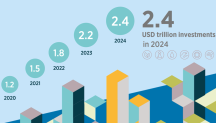

-
-
IEA, IRENA, UNSD, World Bank, WHO. 2023. Tracking SDG 7: The Energy Progress Report. World Bank, Washington DC. © World Bank. License: Creative Commons Attribution—NonCommercial 3.0 IGO (CC BY-NC 3.0 IGO).
Copied
https://www.irena.org/-/media/Files/IRENA/Agency/Publication/2023/Jun/Tracking_SDG7_energy_progress_2023.pdf
Copied
Tracking SDG7: The energy progress report 2023
Newsletter
This annual report tracks global progress toward Sustainable Development Goal (SDG) 7: Achieving affordable, reliable, sustainable and modern energy for all. It serves as a guide for policymakers and the international community in advancing energy access, energy efficiency, renewable energy and international cooperation to achieve SDG 7. IRENA produces the report jointly with the SDG 7 co-custodian agencies: the International Energy Agency (IEA), the United Nations Statistics Division (UNSD), the World Bank, and the World Health Organization (WHO). The preparatory process for the 2023 edition was chaired by the WHO.
The latest data indicate that the world is not on track to achieve any of the SDG7 targets. In 2021, 675 million people still lacked access to electricity. Of those, 567 million people lived in Sub-Saharan Africa – accounting for more than 80% of the global population without access. Meanwhile, 2.3 billion people lacked access to clean cooking, largely in sub-Saharan Africa and Asia. At the current rate of progress, 660 million people are projected to still lack access to electricity in 2030, and 1.9 billion people would continue to rely on polluting cooking fuels. Meanwhile, renewable energy deployment has risen significantly in the power sector, growing by around 27 percent in 2010-2020 and 7 percent in 2019-2020 – the largest annual growth recorded over the past three decades. The share of renewable sources in total final energy consumption reached 19.1 percent globally in 2020, compared to 16.7% in 2010. However, current progress is insufficient and renewable energy deployment must accelerate considerably – particularly in heat and transport. Progress in energy efficiency measures is also off track, with only a 0.6% rate of improvement in 2021. Energy intensity must improve at no less than 3.4 percent annually from now until 2030 to make up for the shortfall. Meanwhile, international public financial flows to developing countries to support clean energy decreased for the third year running, amounting to USD 10.8 billion in 2021. This is only about 40% of the 2017 peak of USD 26.4 billion.
In order to realise SDG 7 and related SDGs by 2030, the SDG 7 custodian agencies emphasise the need for: stronger and more tangible commitments to close the gaps in access to electricity and clean cooking fuels and technologies; a fundamental transformation of the global energy system as a precondition for sustainable development and global energy security; and the importance of international cooperation and financing to deliver on the considerable promise of the energy transition.
Find the dashboards and additional information on the Tracking SDG 7 website.




